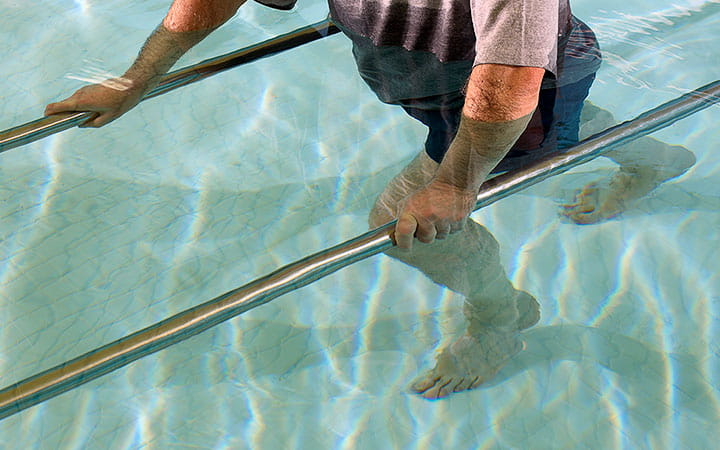Aquatic Therapy Helps Slow Progress of Rare Muscle Disease
January 03, 2022
 Inclusion body myositis (IBM) is a rare inflammatory and degenerative muscle disease that typically causes progressive weakness of the muscles of the hand, forearm, thigh and lower leg, as well as difficulty swallowing.
Inclusion body myositis (IBM) is a rare inflammatory and degenerative muscle disease that typically causes progressive weakness of the muscles of the hand, forearm, thigh and lower leg, as well as difficulty swallowing.
Though the exact cause (or causes) are unknown, evidence suggests the disease has an autoimmune component. Affecting only 1 to 71 individuals per one million, IBM is often a debilitating condition, with many affected individuals needing assistance with mobility or daily care within five years of the onset of their symptoms.
Much more research is needed to develop effective treatments for this disease. In the meantime, physical therapy is one of the most useful treatments for helping people with IBM stay mobile and slow the progress of the disease.
Due to the lower body weakness often caused by IBM, many patients with the disorder are unable to participate fully in land exercise, a circumstance that makes preserving and increasing the strength required to walk, stand or perform everyday activities more difficult. Aquatic therapy, also called water therapy or pool therapy, is a specialized form of physical therapy conducted in temperature-controlled pools. The anti-gravity and resistive properties of aquatic therapy make it an ideal modality for IBM patients.
Joe Sadie is an IBM patient who does physical therapy with Melanie Rohrbach, PT, and Erin Faulstick, PTA, through University Hospitals Parma Medical Center’s Outpatient Rehab program. Erin reports that Joe has benefited significantly from water therapy at the program’s North Royalton YMCA facility (OP Rehab North Royalton YMCA). Joe can independently perform a number of exercises and functional tasks in the pool that, when performed on land, had required maximal assistance (i.e., with the therapist performing about 75 percent of the work while he performed 25 percent). In increasing Joe’s strength and improving his mobility in the water, the ultimate goal is to slow the progression of the disease and keep Joe out of a wheelchair for as long as possible.
Joe’s aquatic treatment consists of resistance walking, core strengthening, upper and lower body strengthening, coordination tasks and balance recovery. Joe has even progressed to walking against a water current, an exercise that is available at OP Rehab North Royalton YMCA. At this facility, Joe has access to all the equipment needed to make adjustments to his individualized therapy program.
“Aquatic physical therapy has given me all the hope I need to fight the disease and slow the progression of its effects,” Joe says. “It has given me confidence to exercise, and the hope that my disease can be held back. With Melanie and Erin’s dedication and care, they make me feel as though I am not alone in this journey.”
Since the onset of his IBM three and half years ago, aquatic physical therapy has helped Joe to keep walking with a wheeled walker and not require a wheelchair.
Tags: Rehabilitation, Physical Therapy


